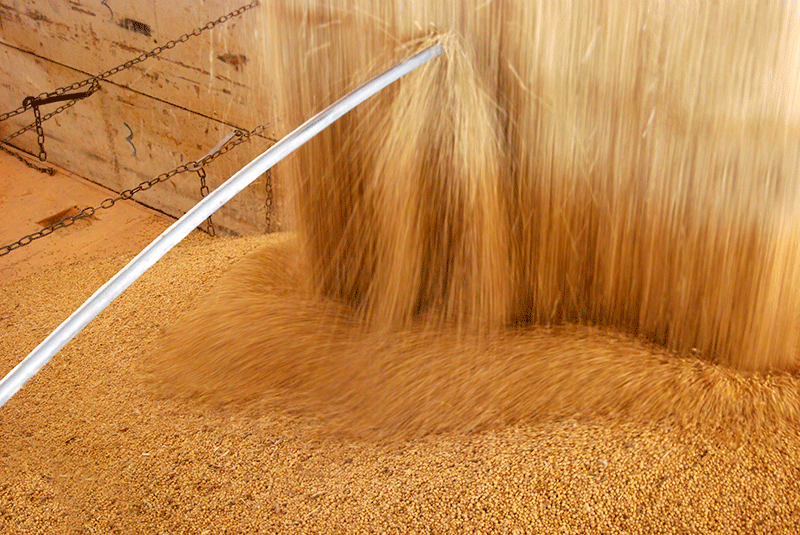Market moves
GRAIN MARKET WATCHERS WEIGH IN ON GLOBAL TRENDS
A BIG BUMP in prospective corn plantings in the U.S., improving transportation routes in South America, a 29-year high in global grain stocks, and the ups and downs of currencies will have the most effect on Ontario crop prices this year.

“We’ve been in a bearish trend on futures prices for grain markets for a couple of years and it looks like it’s going to continue,” says agricultural economist Philip Shaw.
Both Shaw and Brennan Turner, president of FarmLead.com, agree that early spring reports on U.S. prospective plantings were a shocker. The report predicted that 93.6 million acres of corn would be planted, a more than six per cent increase over 2015. The prediction drove corn futures prices down on the day and reinforced the bearish tone that’s been happening for months.
CHINA’S INFLUENCE
Grain Farmers of Ontario’s marketing manager Todd Austin points out that, with China controlling two-thirds of the world’s soybean trade, the current slowdown in the growth rate of that economy could seriously affect demand and prices. China’s 2015 growth rate slowed to 6.9 per cent — the lowest in 25 years. About 17 per cent of Canadian soybean exports were shipped to China in 2014.
FREIGHT RATES
Austin also notes that lower freight rates over the past number of years have meant that far-away countries where it wasn’t economically feasible to ship from in the past can now put grains and oilseeds on a boat and ship anywhere in the world. He says there are stories about how U.S. buyers are importing grains from farther afield because they’re cheaper than domestic or Canadian supplies.
Turner agreed that cheap oil and low shipping indexes mean that international buyers from China, other parts of southeast Asia, or Europe can have their pick of where to get their grain — they just have to be careful of currency risks.
CURRENCY
Shaw points to the value of the Canadian dollar as one of the main factors affecting the grain market. While the loonie was at par with the U.S. dollar in 2013, it plummeted to 68 cents in January this year, and rebounded to about 79 cents at the end of April. As he wrote in his Grain Farmers of Ontario Market Trends column: “The challenge Ontario farmers have is to continue to balance grain futures price movement with Canadian dollar volatility.”
“Net cash corn prices have pulled back by about 12 per cent in Ontario (as of late April),” says Turner. “The currency plus the larger U.S. corn crop delivered a double bearish hit, though the mid-April rally helped erase some of the losses.”
While the Brazilian economy is contracting and the political landscape is in turmoil, the devaluation of the Brazilian real against the U.S. dollar means that country is exporting more grains. Turner says Brazil shipped 11 million tonnes of corn in the first quarter of 2016 — almost triple that of the same period in 2015.
As for soybeans, “South America can produce what North America produces, and on a per bushel basis can produce it more cheaply — but currency is a trump card in any scenario,” he says.
Projections are that Brazil will ship more than 100 million tonnes of soybeans in 2016, as well.
SOUTH AMERICA
Turner says that there is a lot of grain getting exported out of Brazil and Argentina, and it’s increasing all the time, because of improvements to road, rail, and port infra-structure. New routes through northern access points in Brazil are shortening the shipping distances.
“Five years ago, five per cent of shipments came out of northern ports, now, it’s at about 20 per cent — keep in mind that agricultural production has increased over that time, too,” he says.
Argentina has removed export taxes on corn and wheat, and is reducing taxes on soybeans over time. They’ve already been reduced from 35 to 30 per cent and will be phased out completely. The new tax regime and Argentina’s closer proximity to the Pacific Ocean makes it attractive for buyers in the burgeoning southeast Asian economies such as Malaysia, Indonesia, and India, as well as China.
WORLD GRAIN STOCKS
“There’s too much grain — too much of everything,” Shaw says. “With the huge increase in projected plantings of corn in the U.S., we could easily have ending stocks of 2.4 to 2.7 billion bushels next year.”
This, he says, means that any weather scares that come along would be buffered by the stocks.
Turner agrees and adds that U.S. wheat stocks are also up 20 per cent year over year to their highest levels since the late 1980s.
“We have to work through the grain glut before we can expect higher prices — say a 25 per cent premium over today,” he says.
“Opportunities to sell grain at higher prices will be short-lived,” Turner adds. “It all comes back to the fact that stocks are so big that no matter what the crisis, markets will react briefly, but then go back to the lower prices.”
BARLEY AND OATS
The over-supply and lower demand situation is mirrored in barley and oats resulting in continued low prices. In oats, Turner says producers should keep an eye on the buying habits of major companies like Quaker and General Mills, who are looking for stricter traceability systems and are responding to consumer demand for gluten-free products.
Given that barley is easily substitutable for corn in feed, his outlook is neutral to bearish, especially if corn prices stay as low as they were in early April.
He also says that malt barley sales in emerging markets like China and Africa could pick up over the longer term as a result of a growing middle class that’s thirsty for beer.
WEATHER
All three market watchers say that weather is always a consideration when it comes to crop prices. Climate change has meant that extremes are being reached more often, and the predictions are that there will be a transition from El Nino to La Nina late in the year.
Turner thinks that the generally warm dry weather that accompanies La Nina won’t adversely affect North America except to provide a drier harvest season in the fourth quarter of the year. South American production could be affected since farmers there will be planting during the fourth quarter and harvesting in the first quarter of 2017. •

















